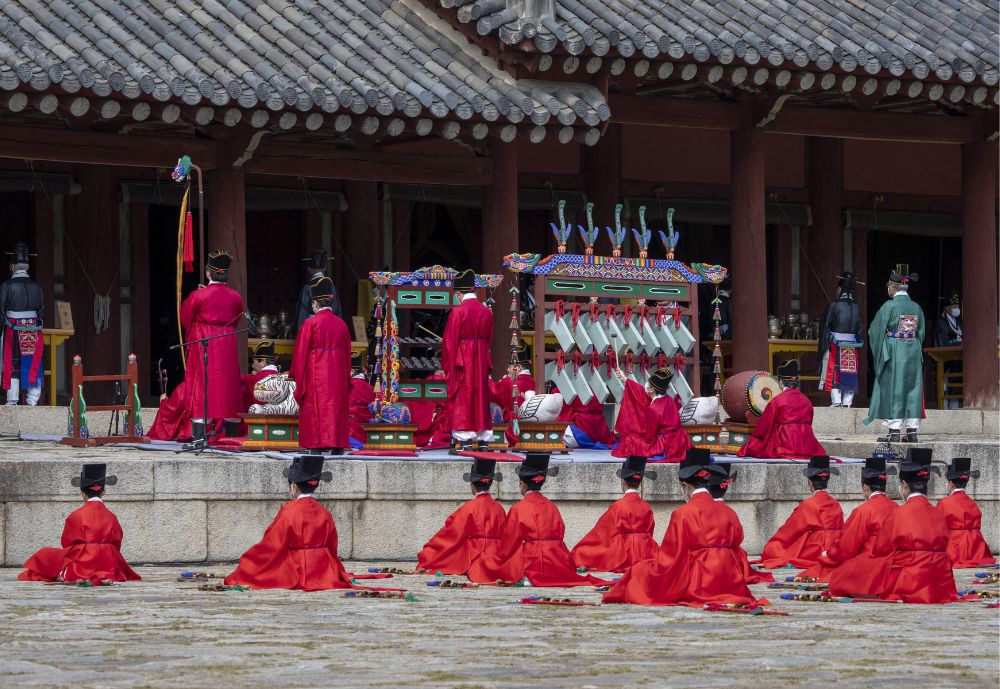
LIST
Hyangdaecheong at Jongmyo: A UNESCO World Heritage Site for History Enthusiasts
Jongmyo, a UNESCO World Heritage site, is a must-visit for K-drama fans, especially those interested in historical dramas and Korean history. The Hyangdaecheong Exhibition Hall provides bleisure tourists with a brief yet enriching historical experience.
| A Place that Holds the History of Jongmyo and Sajik
 Jongmyo is a place where the ancestral tablets of the kings and queens of the Joseon Dynasty are enshrined, and rituals are performed in their honor. Each building within Jongmyo carries deep meaning, such as the main gate, Changyeopmun, named by Jeong Do-jeon, one of Joseon’s founding figures. The name symbolizes the hope that the Joseon Dynasty would flourish eternally, like the ever-growing green leaves.
Jongmyo is a place where the ancestral tablets of the kings and queens of the Joseon Dynasty are enshrined, and rituals are performed in their honor. Each building within Jongmyo carries deep meaning, such as the main gate, Changyeopmun, named by Jeong Do-jeon, one of Joseon’s founding figures. The name symbolizes the hope that the Joseon Dynasty would flourish eternally, like the ever-growing green leaves.
For tourists with ample time, a visit to this royal shrine is highly recommended. Entering through the main gate and following the path, you’ll encounter the beautiful pond, Jungyeonji. This serene spot, offering a refreshing sense of tranquility, has been a source of relaxation and healing since the Joseon era and continues to captivate visitors today.
| Hyangdaecheong: The Waiting Area for Ritual Officials

The Hyangdaecheong Exhibition Hall, opened to coincide with the inauguration of the Cultural Heritage Administration, is divided into two sections: Deuo Room and Jio Room. These names, derived from Jongmyo Jeryeak (the music of Jongmyo rituals), signify the start and end of the music. When the ceremonial conductor shouted "DEUO" and raised a flag, the music began; when they called "Jio" and lowered the flag, the music ended.
| Deuo Room

The sacred shrine is the heart of Jongmyo, housing the ancestral tablets that are considered vessels of the spirits of the deceased. These tablets were treated with utmost respect. In the Joseon Dynasty, not only kings and queens but also nobles and commoners enshrined ancestral tablets and conducted rituals to honor their ancestors.
| Jio Room

After exploring Deuo Room, the next stop is Jio Room. This section focuses on the theme of Jongmyo Rituals and Jongmyo Jeryeak. Both are key representations of Jongmyo and are recognized as National Intangible Cultural Heritage.
The Jongmyo Ritual is a ceremony dedicated to honoring the ancestral tablets of past kings, queens, emperors, and empresses enshrined in Jongmyo. Jongmyo Jeryeak refers to the music, songs, and dances performed during the rituals.
As the most important state ceremony of the Joseon Dynasty, understanding Jongmyo and the Jongmyo Ritual provides valuable insight into the cultural and spiritual foundations of the Joseon era.

Jongmyo may feel unfamiliar and somewhat complex to foreign visitors. However, for those interested in the history of Korea or seeking to understand the roots of the Joseon Dynasty, it is undoubtedly a place worth visiting at least once.

For tourists with ample time, a visit to this royal shrine is highly recommended. Entering through the main gate and following the path, you’ll encounter the beautiful pond, Jungyeonji. This serene spot, offering a refreshing sense of tranquility, has been a source of relaxation and healing since the Joseon era and continues to captivate visitors today.
| Hyangdaecheong: The Waiting Area for Ritual Officials

ⓒ 내 손안에 서울, 임중빈
Behind Jungyeonji, you’ll find Hyangdaecheong, a place where incense, ritual texts, and tribute offerings were stored, and where ritual officials waited during ceremonies. While it once served as a waiting area for officials, today it functions as an exhibition hall, sharing various stories related to Jongmyo.The Hyangdaecheong Exhibition Hall, opened to coincide with the inauguration of the Cultural Heritage Administration, is divided into two sections: Deuo Room and Jio Room. These names, derived from Jongmyo Jeryeak (the music of Jongmyo rituals), signify the start and end of the music. When the ceremonial conductor shouted "DEUO" and raised a flag, the music began; when they called "Jio" and lowered the flag, the music ended.
| Deuo Room

ⓒ 내 손안에 서울, 박분
Deuo Room focuses on exhibitions under the theme of World Heritage Jongmyo, introducing the process of creating ancestral tablets, the history and architecture of Jongmyo, and the sacred shrine spaces. Visiting this area provides foreign tourists, even those unfamiliar with Joseon history, with a better understanding of Jongmyo and its significance.The sacred shrine is the heart of Jongmyo, housing the ancestral tablets that are considered vessels of the spirits of the deceased. These tablets were treated with utmost respect. In the Joseon Dynasty, not only kings and queens but also nobles and commoners enshrined ancestral tablets and conducted rituals to honor their ancestors.
| Jio Room

After exploring Deuo Room, the next stop is Jio Room. This section focuses on the theme of Jongmyo Rituals and Jongmyo Jeryeak. Both are key representations of Jongmyo and are recognized as National Intangible Cultural Heritage.
The Jongmyo Ritual is a ceremony dedicated to honoring the ancestral tablets of past kings, queens, emperors, and empresses enshrined in Jongmyo. Jongmyo Jeryeak refers to the music, songs, and dances performed during the rituals.
As the most important state ceremony of the Joseon Dynasty, understanding Jongmyo and the Jongmyo Ritual provides valuable insight into the cultural and spiritual foundations of the Joseon era.

Jongmyo may feel unfamiliar and somewhat complex to foreign visitors. However, for those interested in the history of Korea or seeking to understand the roots of the Joseon Dynasty, it is undoubtedly a place worth visiting at least once.
